This post is all about understanding sensory issues and sensory processing disorders as stand-alone conditions in children. This post is not to be used in lieu of medical advice. If you have medical concerns about your child, you should contact your pediatrician.
Being a first-time parent is a time of excitement and uncertainty. Every experience is the first exposure to that age and stage of development or behavior. So it can be concerning if you notice that your child is having sensory issues or is behaving in ways that differ from other kids their age.
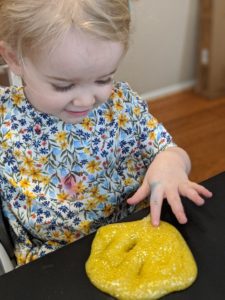
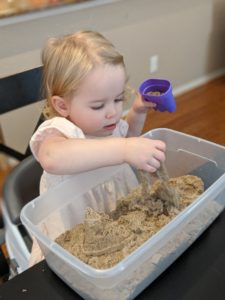
Or maybe you’re a seasoned parent but you still have concerns about your child’s sensory issues.
I don’t know why but when I became a mom a great fear of autism was instilled in me. I definitely overanalyzed everything my child did. She eats like this, walks like this, behaves like this, etc. And my immediate concern was maybe she has autism.
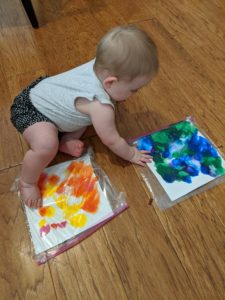
I had no idea that there was such a thing as a sensory processing disorder. I thought sensory issues were just a symptom of autism.
If you are a parent who has a child that is demonstrating certain behaviors or sensitivities, you might be wondering can a toddler have sensory issues and not be autistic?
The answer is yes, a toddler can have sensory issues and not be autistic. If your toddler is experiencing frequent extreme tantrums and inconsolable meltdowns, it’s possible that they have a sensory processing disorder as a stand-alone condition.
What is the importance of identifying and labeling sensory issues?
Receiving Proper Support
Having a toddler in general can be extremely trying. Having a toddler with sensory issues just adds to those difficulties.
There are certain things that are not optional such as diaper changing, getting dressed, brushing hair, taking bath, etc. that could cause a child to have a breakdown. Identifying the source of the struggle means that you can receive treatment and/or support so that these tasks no longer need to be a point of daily stress. Imagine not having to wrestle your toddler to the floor to get them to put on pajama pants. Wouldn’t that be magical!
All jokes aside, having a child that is constantly battling you can really take the joy out of parenthood. After we received help with my daughters sensory issues, I have been able to better connect with her and I feel that it has made us a lot closer.
One of my favorite things that I have heard along the way that has helped me empathize with my child is “They’re not giving you a hard time, they’re having a hard time.”
Receiving Validation
It can be very difficult to differentiate between a sensory processing disorder and regular toddler behavior. As a parent it was extremely challenging because I felt like I was failing. I was doing everything that I was told I should do… whether it was reading books, taking courses, I was working really hard at becoming the best mother that I could be and my child was clearly still having a very hard time.
It was very relieving to discover that this was a thing that toddlers can struggle with as legitimate medical condition. Because that meant it wasn’t my fault. It wasn’t anything I did, I didn’t screw up or fail, it just is. And then we can take steps forward to get additional help.
Insurance Purposes
Getting an official medical diagnosis on paper can help when it comes to paying for therapy.
Signs that your child has a sensory processing disorder
1. Your child is sensory seeking and/or sensory avoiding.
This means that your child either looks for and enjoys certain sensations and/or avoids certain sensations.
Examples of activities that a child might seek and enjoy:
-swimming
-water play
-swinging
-sliding
-playing in sand
Examples of activities that a child might avoid:
-playing with paint, shaving cream, or slime
-washing their hands
-eating certain foods
-touching grass
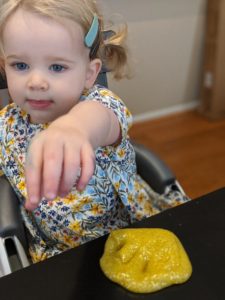
These lists are just examples. Every kid is different and might enjoy or avoid different things. The key is that you see a pattern and that the reactions are strong. For example, my daughter only ever wanted to swing at the park and also had a strong aversion to getting her hands sticky or dirty.
2. Your child displays sensory issues, but is meeting all other social and emotional milestones.
I was never that concerned that my toddler had autism because she was meeting all of the other milestones for her age on time. She was smiling at herself in the mirror, interacting with others, saying a few words, had great fine motor skills, walking, etc. She didn’t display any other tell tale signs of autism. Which is what kind of threw me when I noticed that she had sensory sensitivities.
Based on what I had witnessed with other children her age, something just wasn’t quite the same. Her reactions were just different. Trust your mom instincts. Worst case scenario in being too cautious is that you take your child to be looked at and everything is normal.
3. Your child shows particular interest in rhythmic movement.

I didn’t know until after we saw an occupational therapist that my daughter constantly wanting to swing was actually a sign of a sensory processing disorder. Whenever we went to a park she wouldn’t walk to explore, she would just ask us to swing her for like an hour. Here are some other examples of rhythmic movement that children might show a lot of interest in that might indicate a sensory processing disorder:
-swinging
-jumping on a trampoline
-sliding
-rocking in a rocking chair
These are examples of vestibular movement which are activities that can help organize the way a child’s brain receives sensory input. What does that mean? I go in further depth below.
4. Your child has extreme tantrums and you have a hard time calming them down over seemingly nothing.
This for me was the point at which I decided to see a specialist. I was reading the book No-Drama Discipline, which I highly recommend as a book for positive parenting.
In the book it mentions that toddlers have bigger meltdowns when they are tired or hungry. All parents know this.
But then it said that if a child is having an extreme meltdown even after resolving these things, then they may actually have a sensory processing disorder.
The word “disorder” tends to have a negative connotation because it suggests that something is wrong. In this instance, it literally means dis-order.
Our brains are constantly taking in information and organizing it so that we can function. For children with sensory issues, they cannot organize sensory input and can get easily overwhelmed.
Think about when you’re driving and you turn down the music so that you can better see where to turn. Obviously, we we don’t need it to be quiet in order to see, but getting rid of additional input can help us focus.
For a child with a sensory processing disorder, their brains can’t organize input. So any sensory experience could be extremely overwhelming. Hence, meltdowns.
How to receive a “diagnosis”
The first step is to go to your child’s pediatrician.
We went to our pediatrician who then referred us to an Occupational Therapist.
It depends on your pediatrician but ours gave us a referral via our patient portal. You probably don’t need to actually go in because it’s not guaranteed that the child would demonstrate sensory issues within the time at the office.
The wait to get in to see an occupational therapist can be a while. It took us a month from when we received our referral to get an appointment for an evaluation. Especially since COVID, occupational therapists are just in higher demand because of the developmental challenges that the pandemic presented for children.
What Can I Expect In Occupational Therapy?
If you don’t know what an occupational therapist (OT) is, they are therapists that help people make adjustments so they are able to perform their daily tasks. A child’s “occupation” is play.
First, they will do an evaluation.
Our daughter was evaluated and the conclusion was that she had “tactile defensiveness”. This means she really didn’t like being touched and would pretty much avoid it at all costs.
This conclusion determined what we would work on in therapy for the bulk of our sessions.
Sessions are typically once a week for an hour. It can be twice a week
When we started I was so curious what exactly the “treatment” was going to be.
We went to two different pediatric therapy practices and the offices had a very similar set up.
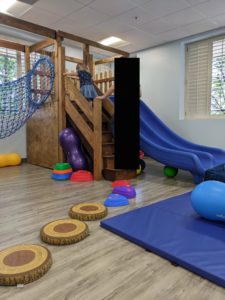
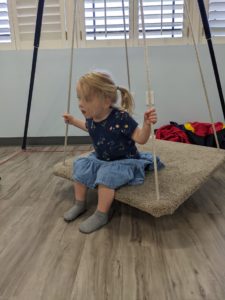
They both had large rooms with mirrors (kind of like an exercise room) with a bunch of different activities placed throughout the room. For example, slides, trampolines, obstacle courses, swings, stairs, climbing walls, puzzles, and toys, etc.
My first impression was like woah, this is fun! And truthfully it is fun! When we went, I just told my daughter we were going to play because it was more accurate than saying we were going to a doctor.
During the sessions, the therapist does guided play with the child. They will follow the child’s lead and then expose them to situations that they are uncomfortable with in order to help teach them work through their sensory issues.
For the first few sessions, the parent is present and then I believe in most cases the parent won’t be in the session. This is because sometimes a parent’s presence can do more harm than good. The kid might be fussier, more resistant to playing, etc.
As an example of something that the occupational therapist helped us with, is that my daughter was terrified of slides. After going to a couple of sessions and being exposed to a small slide with guidance, she overcame her fear of slides and now loves them.
This is a small example of success from therapy. My daughter will also now hug me all the time and actually request hugs. She used to not hug me at all.
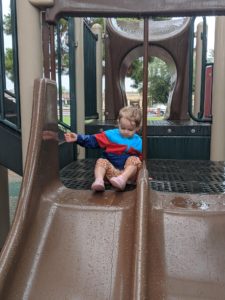
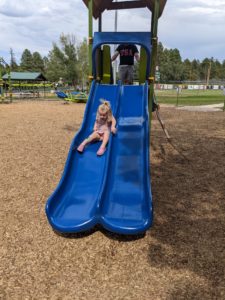
Does my child need occupational therapy?
We had a lot of questions when deciding whether or not to do occupational therapy.
Because like most things, it’s expensive.
It feels less black and white than other treatments. Like if someone breaks their arm, obviously they need a cast.
We were wondering will she just grow out of these behaviors over time? Is this just the ‘terrible twos’?
My suggestion would be to see how your child plays with other kids their age. See how the other kids are playing/ interacting/ responding to certain situations. If their reactions are more extreme in certain situations, or they are more reluctant to do different activities, it might be worth looking into.
You can also seek advise from someone you trust.
We asked our preschool director. She advised us that in general, it is not normal for a 2 year old to avoid physical affection.
Most young children seek touch for comfort, even at school. And she wasn’t doing that. She didn’t want to be touched at all, ever.
It doesn’t hurt to try occupational therapy and just see if there is any improvement in your child’s day to day life.
How Long Does it take to “treat” sensory issues?

Unfortunately, treating sensory issues is not a quick fix. It is something that is worked on slowly over time.
That being said you can see improvement with each occupational therapy session.
The thing that was most comforting to me was being told that the sooner you address your child’s sensory issues, the better. Early intervention is one of the best things you can offer your child so that they don’t struggle down the road. As behaviors become more set in, the more difficult and expensive it will be to correct them.
We started going to OT when my daughter was a little over 2 years old. Now she is almost three and I can confidently say that it has changed our lives.
Occupational therapy helped us tremendously. I really didn’t understand sensory issues at all.
OT helped me to better understand my daughter and it has made us so much closer in the process.
Things you can try with a child with sensory issues
I just want to reiterate that I am NOT a medical professional, I am not a doctor or an occupational therapist, so these things should only be used under supervision and approval of a medical professional.
There are things that you can do from home that can help your child with their sensory processing disorder.
Compressions
Deep pressure touch is something that can positively affect the way the brain processes sensory input. There have been many times when my daughter is having a breakdown and I will invite her to sit on my lap and I will slowly squeeze her legs and arms. Like getting a deep pressure massage. It’s comforting and has helped her to calm down 9/10 times.
Vestibular Movement
To get an understanding of what vestibular movement is, click here.
We find that when our daughter has the opportunity to do different vestibular activities throughout the day, her mood and behavior improve.
For example, if we take her swimming it’s almost as if that activity gives her what she needs in order to handle the rest of the sensory input throughout the day. I have heard this from other parents as well. They see and improvement in their child’s overall behavior when they have the opportunity for vestibular movement.

Some ideas of vestibular activities are: swimming, sliding or swinging at a local park, building an obstacle course at home that allows them to climb and jump and crawl, jumping on a trampoline, or dancing to fun music. It doesn’t have to be anything fancy.
If you want to learn how to create a sensory friendly environment at home check out this article.
Modeling
This method is so simple yet effective. Children want control and independence. If you show them an activity and then let them try it for themselves, they will be more willing to do it for themselves or cooperate in general.
For example, if your child is reluctant to brush their teeth, have them brush a dolls teeth first.
If they don’t want to stay in bed at night, give them the responsibility to make sure their baby doll stays in bed all night.
This method can be used for just about anything. All you need is some dolls or stuffed animals and some creativity.
Of course no method is fool proof. Kids will still choose not to cooperate and just do whatever they want instead. But I’ve found that this method does help most of the time.
As someone once told me, children are wearing earmuffs, but looking through binoculars. They wont listen to what you say, but they observe everything very closely.

A word on brushing
The Wilbarger Protocol or “brushing” is taking a soft silicone brush with many small bristles and using it to rub your child’s extremities. This can help organize the sensory input that they are receiving. I had never heard of brushing until we went to occupational therapy.
After doing some research, I realized that brushing is sort of trending right now. I personally did not see any benefit from brushing. My daughter hated it, and honestly so did I. I once let her brush me and it didn’t feel good, it felt scratchy.
I just didn’t want to leave this out of the article because it does come up a lot as a treatment for sensory issues.
Here is an article that breaks it down in more detail.
The #1 thing not to do when you have a child with a sensory processing disorder
Do NOT make comparisons.
Don’t compare your child to other children. And do NOT compare yourself to other parents. I’m telling you it will lead to misery for no reason.
People with children who don’t have a sensory processing disorder are going to have a very different experience. Things will work for their kids that won’t work for yours (don’t get me started on 3 day potty training).
Your kid walks around with messy hair while another child’s is perfectly in place? Fine.
Your child has yogurt all over their face, while other kids’ faces are pristine? Great.
I am admitting this at the risk of embarrassing myself, but I used to let my toddler walk around with a crusty booger-y face. Just because the process of wiping her face made everyone within a 50 ft radius miserable. Her happiness was worth having people give us looks (and sometimes come try to wipe her, I kid you not. I love people don’t you?).
Yes, children don’t like having their faces wiped. That is a fact of life. But we had tried wipes, tissues, warm wash cloths, having her do it herself, have her do it while looking in a mirror and so on and so forth. Every time it would lead to a breakdown of epic proportions and even more boogers on her face. A vicious cycle.
In conclusion
If you are a parent going through this, just know you are not alone. And that you are doing a great job! If you made it through this whole article it means you are a caring parent who wants the best for your child. I wish you and your child lots of success along this journey!


